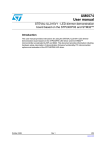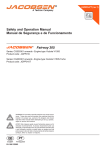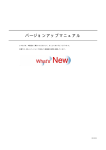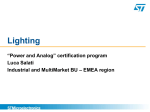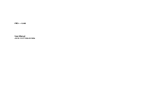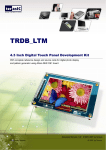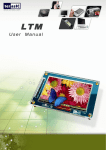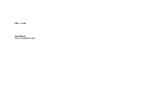Download STEVAL-ILL028V1 LED dimmer board using
Transcript
UM0882 User manual STEVAL-ILL028V1 LED dimmer board using STP1612PW05 and STM32™ 1 Introduction This user manual describes STMicroelectronics™ STEVAL-ILL028V1 LED dimmer board. This board is based on STP1612PW05 independent PWM LED driver controlled through STM32 microcontroller SPI interface and DMA (optional). This document explains how to use the board: hardware setup, demonstration firmware functions, possible interconnections with PC and evaluation of STP1612PW05. Figure 1. July 2010 STEVAL-ILL028V1 LED dimmer board Doc ID 16881 Rev 2 1/20 www.st.com Contents UM0882 Contents 1 Introduction . . . . . . . . . . . . . . . . . . . . . . . . . . . . . . . . . . . . . . . . . . . . . . . . 1 2 Board function overview . . . . . . . . . . . . . . . . . . . . . . . . . . . . . . . . . . . . . 5 3 Hardware setup . . . . . . . . . . . . . . . . . . . . . . . . . . . . . . . . . . . . . . . . . . . . . 6 4 3.1 Power supply . . . . . . . . . . . . . . . . . . . . . . . . . . . . . . . . . . . . . . . . . . . . . . . 6 3.2 Microcontroller JTAG . . . . . . . . . . . . . . . . . . . . . . . . . . . . . . . . . . . . . . . . . 6 3.3 Microcontroller clock, reset, USB clock . . . . . . . . . . . . . . . . . . . . . . . . . . . 6 3.4 Jumpers for LED failure simulation . . . . . . . . . . . . . . . . . . . . . . . . . . . . . . . 6 Description of the demonstration firmware functions . . . . . . . . . . . . . . 7 4.1 Mode “A” - interactive demonstration - color Tetris . . . . . . . . . . . . . . . . . . . 8 4.2 Mode “B” - wave color demonstration . . . . . . . . . . . . . . . . . . . . . . . . . . . . . 8 4.3 Mode “C” - solid color demonstration . . . . . . . . . . . . . . . . . . . . . . . . . . . . . 8 4.4 Mode “D” - error detection . . . . . . . . . . . . . . . . . . . . . . . . . . . . . . . . . . . . . 8 5 PC demonstration firmware software . . . . . . . . . . . . . . . . . . . . . . . . . . . 9 6 Schematics . . . . . . . . . . . . . . . . . . . . . . . . . . . . . . . . . . . . . . . . . . . . . . . 13 7 Bill of material . . . . . . . . . . . . . . . . . . . . . . . . . . . . . . . . . . . . . . . . . . . . . 17 8 Revision history . . . . . . . . . . . . . . . . . . . . . . . . . . . . . . . . . . . . . . . . . . . 19 2/20 Doc ID 16881 Rev 2 UM0882 List of tables List of tables Table 1. Table 2. Bill of material . . . . . . . . . . . . . . . . . . . . . . . . . . . . . . . . . . . . . . . . . . . . . . . . . . . . . . . . . . . 17 Document revision history . . . . . . . . . . . . . . . . . . . . . . . . . . . . . . . . . . . . . . . . . . . . . . . . . 19 Doc ID 16881 Rev 2 3/20 List of figures UM0882 List of figures Figure 1. Figure 2. Figure 3. Figure 4. Figure 5. Figure 6. Figure 7. Figure 8. Figure 9. Figure 10. Figure 11. Figure 12. Figure 13. Figure 14. Figure 15. Figure 16. 4/20 STEVAL-ILL028V1 LED dimmer board . . . . . . . . . . . . . . . . . . . . . . . . . . . . . . . . . . . . . . . . 1 Setup of the board . . . . . . . . . . . . . . . . . . . . . . . . . . . . . . . . . . . . . . . . . . . . . . . . . . . . . . . . 6 The menu; the letter “A” indicates the first item of the menu . . . . . . . . . . . . . . . . . . . . . . . . 7 The control buttons . . . . . . . . . . . . . . . . . . . . . . . . . . . . . . . . . . . . . . . . . . . . . . . . . . . . . . . . 7 Simulation of LED defect by setting/removing P21 to P2 jumpers . . . . . . . . . . . . . . . . . . . . 8 Software - Windows® application . . . . . . . . . . . . . . . . . . . . . . . . . . . . . . . . . . . . . . . . . . . . . 9 USB host (PC) detection in progress . . . . . . . . . . . . . . . . . . . . . . . . . . . . . . . . . . . . . . . . . 10 USB host (PC) detected . . . . . . . . . . . . . . . . . . . . . . . . . . . . . . . . . . . . . . . . . . . . . . . . . . . 10 USB host (PC) not found . . . . . . . . . . . . . . . . . . . . . . . . . . . . . . . . . . . . . . . . . . . . . . . . . . 10 Manual board connection . . . . . . . . . . . . . . . . . . . . . . . . . . . . . . . . . . . . . . . . . . . . . . . . . . 11 Board connected successfully . . . . . . . . . . . . . . . . . . . . . . . . . . . . . . . . . . . . . . . . . . . . . . 11 Error detection mode performed . . . . . . . . . . . . . . . . . . . . . . . . . . . . . . . . . . . . . . . . . . . . . 12 Connectors, buttons, UART . . . . . . . . . . . . . . . . . . . . . . . . . . . . . . . . . . . . . . . . . . . . . . . . 13 Microcontroller, USB, power supply . . . . . . . . . . . . . . . . . . . . . . . . . . . . . . . . . . . . . . . . . . 14 High brightness LEDs . . . . . . . . . . . . . . . . . . . . . . . . . . . . . . . . . . . . . . . . . . . . . . . . . . . . . 15 LED drivers . . . . . . . . . . . . . . . . . . . . . . . . . . . . . . . . . . . . . . . . . . . . . . . . . . . . . . . . . . . . . 16 Doc ID 16881 Rev 2 UM0882 2 Board function overview Board function overview The STEVAL-ILL028V1 demonstration board features: ● Three STP1612PW05 (QFN24 4 x 4 mm) connected to 16 RBG LEDs ● 16 RGB high brightness LEDs ● One STM32 microcontroller using internal HS oscillator ● An ST1S10: a high-efficiency switching DC-DC power supply ● 7.5 - 18 V DC power supply with undifferentiated polarity and overvoltage protection ● DC input current 0.7 A max., standard supply connector ● LED current regulation ● The board can be controlled by 3 buttons, a knob and a reset/back button ● Test point for each main signal ● Microcontroller firmware update through JTAG interface ● Error LED and overtemperature LED for each LED driver ● 3 jumpers to disconnect the LEDs from the driver to test the error detection mode ● 3 jumpers to enable LED shortage from the driver to test the error detection mode ● Mini USB to connect the board to a PC The board is delivered with a firmware allowing to evaluate the board features in standalone and nonstandalone mode: ● LED diagnostic ● Adjustable brightness of each LED ● Adjustable color of each LED ● Animated text ● GUI software for LED diagnostic (see Figure 6). Doc ID 16881 Rev 2 5/20 Hardware setup 3 UM0882 Hardware setup The main board components are shown on Figure 2. Figure 2. 3.1 Setup of the board Power supply The board is powered by a 7.5 to 18 V DC voltage. The power source must be able to deliver a 0.7 A current. Since the board has a built-in diode bridge, the polarity of the input voltage is not specified. 3.2 Microcontroller JTAG The board is equipped with a standard 20-pin JTAG connector allowing to debug and develop the STM32 microcontroller. 3.3 Microcontroller clock, reset, USB clock The STM32 on-board microcontroller uses its internal RC oscillator to generate an 8 MHz clock (that is converted to 48 MHz by a PLL). The clock is also used to drive USB. Since the internal RC oscillator does not allow to achieve the clock stability defined in USB specifications, it is recommended not to use the internal RC oscillator in conjunction with the USB interface. The USB is used only for demonstration purpose, but the performance is limited due to this internal RC oscillator stability. 3.4 Jumpers for LED failure simulation LED defects can be simulated by using P20, P21 and P22 jumpers: 6/20 ● Removing a jumper on P20, P21 and P22 causes D1, D2 and D3 green LED opencircuit ● Placing a jumper on P1, P2, and P3 causes D6, D9 and D12 blue LED short-circuit. These simulated defects can be detected during the activation of the error detection mode (see Section 4). The defective LED is highlighted by switching on the corresponding red LED. Doc ID 16881 Rev 2 UM0882 4 Description of the demonstration firmware functions Description of the demonstration firmware functions The main features of the firmware are: ● Brightness control for each LED ● Color control for each LED ● Error detection to detect LED failure ● Simulation Tetris game. The RGB LEDs are switched on to display letter 'A', 'B', 'C' or 'D'. Each letter represents a menu option (or mode). The firmware mode menu items: ● Mode “A” interactive demonstration - color Tetris ● Mode “B” wave color demonstration ● Mode “C” solid color demonstration ● Mode “D” error detection demonstration. After power-up, the letter 'A' is displayed blinking. An action on a button or on the knob allows to select the required mode and display another letter. Figure 3. The menu; the letter “A” indicates the first item of the menu The board can be controlled by four buttons and one knob, Figure 4: ● Button back/reset - exit from current task in to the main menu ● Button left - turn the mode menu decrementally ● Button center - enter the choosen mode in menu ● Button right - turn the mode menu incrementally ● Knob - changes the color of the menu from blue to red. Figure 4. The control buttons Doc ID 16881 Rev 2 7/20 Description of the demonstration firmware functions 4.1 UM0882 Mode “A” - interactive demonstration - color Tetris Mode 'A' performs a simple interactive demonstration similar to Tetris game. The game starts with a green brick moving from the bottom to the top of the LED area. The brick position can be controlled by using the right and left buttons. Once the brick reaches the top of the LED area of another already settled brick, it stops and turns to blue. A blue brick cannot be moved. When a row is full of blue bricks, it disappears and the player scores points. The game ends as soon as the blue bricks reach the bottom of the LED area. When the game is over, the score is displayed. Pressing the center button starts a new game. The knob changes the light brightness of the LEDs. 4.2 Mode “B” - wave color demonstration Mode “B” shows different color effects. The effect can also be changed manually by using the center button. The knob changes the speed of the effect. 4.3 Mode “C” - solid color demonstration Mode “C” allows to display a given color on the LEDs. Pressing the right button changes the colors in this order (left button in reverse order): red, green, blue, yellow (red + green), cyan (green + blue), magenta (red + blue), white (red + green + blue) and black (all LEDs are off). The knob changes the light brightness of the LEDs. 4.4 Mode “D” - error detection Mode 'D' performs LED error detection, and displays the error. Error detection is performed by LED drivers every 2 seconds. If a defective LED is found, it is signalled by switching on the corresponding red LED. D1, D2 and D3 green LED open-circuit defect can be simulated by removing P20, P21, or P22 jumper. D6, D9 and D12 blue LED short-circuit defect can be simulated by closing P1, P2, or P3 jumper. Figure 5. 8/20 Simulation of LED defect by setting/removing P21 to P2 jumpers Doc ID 16881 Rev 2 UM0882 5 PC demonstration firmware software PC demonstration firmware software PC demonstration software supplied with the board can work together with the board firmware using USB interface. The software can detect the board, drive it by mouse instead of the on-board buttons, trigger and visualize the result of the error detection. Figure 6. Software - Windows® application The following steps are required to run the PC demonstration software correctly: 1. Disconnect the power supply from the board. 2. Connect the board to the computer through the USB cable. 3. Connect the board to the power supply. 4. If Windows asks for the installation of an appropriate driver, use STMicroelectronics VirtualCOMPort. Doc ID 16881 Rev 2 9/20 PC demonstration firmware software 10/20 UM0882 Figure 7. USB host (PC) detection in progress Figure 8. USB host (PC) detected Figure 9. USB host (PC) not found 5. Run SWforDimmer.exe. 6. If the board is not detected automatically, click “Find board on COM port” on the menu as shown in Figure 10. Doc ID 16881 Rev 2 UM0882 PC demonstration firmware software Figure 10. Manual board connection If the board has been found and connected successfully, the message ''Board found on COM4” is displayed in green as depicted on Figure 11. Figure 11. Board connected successfully Doc ID 16881 Rev 2 11/20 PC demonstration firmware software UM0882 To perform error detection, click “Perform error detection”. Error detection is performed correctly and does not depend on the board operating mode. Figure 12. Error detection mode performed The evaluation of the error detection through the USB interface: 12/20 1. Jumpers P20, P21 and P22 are closed and the jumpers P1, P2 and P3 are open, the PC demonstration software will not report any LED defect after clicking ”Perform error detection”. See Figure 12. 2. Moving the jumper from P21 to P2 after performing error detection will display the simulated defective green LED on the first row and second column, and the simulated defective blue LED on the third row and third column. 3. Exit the PC demonstration software, and disconnects the board. You can then start testing another board. Doc ID 16881 Rev 2 2 1 LD5 red 2.0 V R16 2.2 kV 3 2 1 Doc ID 16881 Rev 2 R23 10 KΩ R22 10 KΩ R20 10 KΩ INHIBIT GND VIN USRX USTX USDIR 4 5 JTRST JTDI JTMS JTCK JRTCK JTDO JRST DBGRQ C14 100 nF 16 V (10 V) 10 nF C8 3.3 V CN1 GM: MLW20G 2 4 6 8 10 12 14 16 18 20 3.3 V Hole1 HOLE DDD1 ST ST_LOGO C13 100 nF ADC R46 100 Ω Distance hole Hole2 HOLE DDD2 ROH1 ROH1 330 Ω R15 C10 100 nF RESET/EXIT S4 JRST Distance hole P5 Power for serial 1 2 1 2 3 P4 Signal for serial C7 10 µF size A tantal (A) 1 3 5 7 9 11 13 15 17 DBGACK 19 3V3 3.3 V NC VOUT LF33xDT, LD3985M33R U5 1 Hole4 HOLE DDD3 ROH2 ROH2 R17 VarRez 10 KΩ S2 3.3 V R48 100 Ω C17 100 nF 3.3 V C12 100 nF PC14 CENTER Distance hole Distance hole Hole3 HOLE DDD4 ROH1 ROH1 2 3 R47 100 Ω C11 100 nF 3.3 V LEFT S1 PC13 AM00675 C16 100 nF RIGHT S3 PC15 6 3.3 V 4.5 V UM0882 Schematics Schematics Figure 13. Connectors, buttons, UART 13/20 14/20 1 2 3 D18 Doc ID 16881 Rev 2 3.3 V JRST JTRST TIM2ETR TIM2CH 2 PC13 PC14 PC15 EXTCLK ST: SM6T18AC GM: K375A CN5 1 2 3 4 5 6 7 8 9 10 11 12 3.3 V 4 C3 100 nF C1 4.7 µF (10 µF) ceramic (C,D,E) 25 V (35 V) ADC SDO CLK LE SDI 13 14 15 16 17 18 PWCLK 3.3 V 19 20 21 22 23 24 VBAT VDD_2 PC13 VSS_2 PC14 PA13 PC15 PA12 PD0_OSC-I N PA11 PD1_OSC-OUT PA10 STM32 NRST PA 9 VSSA PA 8 VDDA PB15 PA 0-WK UP PB14 PA5-CLK(SPI1 ) PA 1 PB13 PA6- MI SO(SPI1) PA 2 PB12 PA7- MOSI(SPI1) PB1 PB10 VSS_1 PA3 PA 4 PB0 PB2 PB11 VDD_1 PB5 PB3 PA14 VDD_3 PB9 BOOT0 PB8 PB7 PB6 PB4 PA15 VSS_3 42 41 40 39 38 37 JTDI JTCK USRX USTX USDIR JTRST JTDO D17 bridge LH 1 48 47 46 45 44 43 2 3 VIN_SW U4 ST1S10 SW 7 4 36 35 34 33 32 31 30 29 28 27 26 25 3 2 1 CLKOUT JTMS USBDP USBDN U3 STM32F103Cx(C6T6) 9 5 33 Ω R19 1.2 kΩ R18 5.6 kΩ VCC D3 VCC D4 4 5 6 3.3 V 100 KΩ 4.7 nF 1.5 kΩ 33 Ω R25 USB_ESD D2 GND D1 U6 3.3 V C5 L1 2.2 µF 4 3 2 1 5 440247- 2 GND D+ D– VBUS AM00673 C4 100 µF (47 µF) size D, 16 V (D) tantal 16 V (10 V) 4.5 V SHLD J1 470 nF C2 MSS7341-332NLB coil craft 8 ST1S10 2 SYNC PGND EN 1 3 VIN_ A FB AGND 6 Schematics UM0882 Figure 14. Microcontroller, USB, power supply Doc ID 16881 Rev 2 D131 D101 D71 D41 D11 27 Ω R34 27 Ω R33 27 Ω R32 27 Ω R31 27 Ω R30 CR CG CB CR D132 CG D133 CB CR D102 CG D103 CB D72 D73 D42 D43 CR CG CB CR D12C CG D1 3 CB A A D61 D31 1 A D91 D121 A D151 RGB LED A D161 27 Ω R45 27 Ω R39 CR D162 CG D163 CB CR D142 CG D143 CB A RGB LED CR CG CB D16 A RGB LED CR CG CB 4.5 V A 27 Ω R44 CR D152 CG D153 CB CR CG CB A A RGB LED CR CG CB D15 CR CG CB 4.5 V A 4.5 V A 27 Ω D14 D141 A D13 CR CG CB RGB LED 27 Ω CR D112 CG D113 CB CR D122 CG D123 CB CR CG CB RGB LED A R38 R43 D92 D93 CR CG CB RGB LED CR CG CB 4.5 V A 4.5 V A 27 Ω R42 D12 A 4.5 V A D9 CR CG CB D8 A D11 D82 D83 CR CG CB CR CG CB D10 27 Ω R37 27 Ω RGB LED A RGB LED CR CG CB D62 D63 CR CG CB D3 RGB LED D111 D81 D52 D53 CR CG CB CR CG CB CR D32C CG D33 CB RGB LED A 4.5 V A 27 Ω R36 R41 27 Ω R40 RGB LED CR CG CB D7 RGB LED CR CG CB 4.5 V A 4.5 V A 4.5 V A D6 CR CG CB D2 D5 CR D22C CG D23 CB D4 27 Ω R35 RGB LED D51 D21 RGB LED A 4.5 V A RGB LED CR CG CB D1 AM00674 4.5 V A 4.5 V A 4.5 V A 4.5 V A 4.5 V A UM0882 Schematics Figure 15. High brightness LEDs 15/20 16/20 Doc ID 16881 Rev 2 D12C D12 0 LE D161 D151 D141 D131 D121 R5 68 kΩ STP1612 QFN24 OUT15 OUT14 OUT13 OUT12 OUT11 OUT10 Header 2 1 2 D111 7 D101 8 Header 2 1 2 P1 D11 D21 D31 D41 D51 D61 D22C D22 100 nF 3.3 V C9 18 17 16 15 14 13 D71 D81 10 11 12 D63 4.5 V D91 9 OUT5 OUT7 OUT8 OUT6 GND OUT9 COOL LE OUT0 OUT1 OUT2 OUT3 OUT4 P20 1 2 3 4 5 6 REXT SDO VDD PWCLK U1 STP1612PW05 PWCLK SDOI1 CLK SDI 3.3 V 22 21 20 19 SDI 24 23 CLK 1 2 3 4 5 6 21 20 19 STP1612 QFN24 OUT15 OUT14 OUT13 OUT12 OUT11 OUT10 REXT SDO VDD PWCLK 22 7 8 9 D93 4.5 V D112 D102 D92 Header 2 1 2 P2 D72 D8 2 10 11 12 18 17 16 15 14 13 D32C D32 100 nF 3.3 V C15 D12 D22 D32 D42 D52 D62 U2 STP1612PW05 PWCLK SDOI2 OUT5 OUT7 OUT8 COOL OUT6 GND OUT9 LE OUT0 OUT1 OUT2 OUT3 OUT4 CLK SDI 24 23 Header 2 1 2 P21 0 LE D162 D152 D142 D132 D122 R6 68 kΩ SDOI1 CLK 3.3 V 1 2 3 4 5 6 Header 2 1 2 P22 0 LE D163 D153 D143 D133 D123 R7 68 kΩ 22 21 STP1612 QFN24 OUT15 OUT14 OUT13 OUT12 OUT11 OUT10 8 9 D123 4.5 V D113 D103 D93 7 Header 2 1 2 P3 D73 D83 10 11 12 OUT5 OUT7 OUT8 COOL OUT6 GND OUT9 LE OUT0 OUT1 OUT2 OUT3 OUT4 D13 D23 D33 D43 D53 D63 AM00676 100 nF 3.3 V C18 18 17 16 15 14 13 U7 20 19 STP1612PW05 PWCLK SDO CLK SDI VDD SDO REXT PWCLK 24 23 SDOI2 CLK 3.3 V Schematics UM0882 Figure 16. LED drivers UM0882 Bill of material 7 Bill of material Table 1. Bill of material Reference Comment Description Footprint C1 4.7 µF (10 µF) Tantal capacitor polarized 1812LH C2 470 nF Capacitor 0805 C3 100 nF Capacitor 0805 C4 100 µF (47 µF) size D, 16 V Tantal capacitor polarized 7343_LH C5 4.7 nF Capacitor 0805 C7 10 µF size A 16 V (10 V) Tantal capacitor polarized 3528_ABLH C8 10 nF Capacitor 0805 C9 - C18 100 nF Capacitor 0805 CN1 Female connector with key Header 10 x 2, JTAG, 10-pin, dual row HDR2X10keyLH CN5 Jack input connector Input power, 4.4V-36V DC10B D1 - D16 RGB LED OSRAM LATB_T686 TOPLED D17 Diode bridge Full wave diode bridge GMBridgeBig D18 Protection diode SM6T18AC SMA DDD1 ST_LOGO Label ST LOGO DDD2 ROH1 Label ROH1 DDD3 ROH2 Label ROH2 DDD4 ROH1 Label ROH1 hole1 hole4 Distance hole Drill J1 440247-2 USB 2.0, right angle, SMT, B type, receptacle, 440247LH 5 position, black L1 2.2 µF Inductor Inductor332 LD5 Red Typical red/amber GaAs LED D0805LH P1, P2, P3 Header 2 Header, 2-pin HDR1X2 P4 Signal for serial Header, 3-pin HDR1X3 P5 Power for serial Header, 2-pin HDR1X2 P20, P21, P22 Header 2 Header, 2-pin HDR1X2 R5, R6, R7 68 kΩ Resistor 0805 R15 330 Ω Resistor 0805 R16 2.2 kΩ Resistor 0805 R17 VarRez Potentiometer VR5 R18 5.6 kΩ Resistor 0805 Doc ID 16881 Rev 2 17/20 Bill of material Table 1. UM0882 Bill of material (continued) Reference Comment Description Footprint R19 1.2 kΩ Resistor 0805 R20, R22, R23 10 KΩ Resistor 0805 R25 100 KΩ Resistor 0805 R30 - R45 27 Ω Resistor 0603LH R46, R47, R48 100 Ω Resistor 0805 S1 Left Button Button_double S2 Center Button Button_double S3 Right Button Button_double S4 RESET/EXIT Small button Button_DT2112C U1 STP1612PW05 STP1612PW05 QFN24 QFN24_STP1612PW05 U2 STP1612PW05 STP1612PW05 QFN24 QFN24_STP1612PW05 U3 STM32F103C6T6 Microcontroller STM32 TQFP48 U4 ST1S10 ST1S10 DFN8cool4LH U5 LD3985M33R Linear voltage stabilisator SOT23-5L U6 USB_ESD USB signal overvoltage protection SOT666IP U7 STP1612PW05 STP1612PW05 QFN24 QFN24_STP1612PW05 18/20 Doc ID 16881 Rev 2 UM0882 8 Revision history Revision history Table 2. Document revision history Date Revision Changes 12-Mar-2010 1 Initial release. 08-Jul-2010 2 Updated Section 2: Board function overview. Doc ID 16881 Rev 2 19/20 UM0882 Please Read Carefully: Information in this document is provided solely in connection with ST products. STMicroelectronics NV and its subsidiaries (“ST”) reserve the right to make changes, corrections, modifications or improvements, to this document, and the products and services described herein at any time, without notice. All ST products are sold pursuant to ST’s terms and conditions of sale. Purchasers are solely responsible for the choice, selection and use of the ST products and services described herein, and ST assumes no liability whatsoever relating to the choice, selection or use of the ST products and services described herein. No license, express or implied, by estoppel or otherwise, to any intellectual property rights is granted under this document. If any part of this document refers to any third party products or services it shall not be deemed a license grant by ST for the use of such third party products or services, or any intellectual property contained therein or considered as a warranty covering the use in any manner whatsoever of such third party products or services or any intellectual property contained therein. UNLESS OTHERWISE SET FORTH IN ST’S TERMS AND CONDITIONS OF SALE ST DISCLAIMS ANY EXPRESS OR IMPLIED WARRANTY WITH RESPECT TO THE USE AND/OR SALE OF ST PRODUCTS INCLUDING WITHOUT LIMITATION IMPLIED WARRANTIES OF MERCHANTABILITY, FITNESS FOR A PARTICULAR PURPOSE (AND THEIR EQUIVALENTS UNDER THE LAWS OF ANY JURISDICTION), OR INFRINGEMENT OF ANY PATENT, COPYRIGHT OR OTHER INTELLECTUAL PROPERTY RIGHT. UNLESS EXPRESSLY APPROVED IN WRITING BY AN AUTHORIZED ST REPRESENTATIVE, ST PRODUCTS ARE NOT RECOMMENDED, AUTHORIZED OR WARRANTED FOR USE IN MILITARY, AIR CRAFT, SPACE, LIFE SAVING, OR LIFE SUSTAINING APPLICATIONS, NOR IN PRODUCTS OR SYSTEMS WHERE FAILURE OR MALFUNCTION MAY RESULT IN PERSONAL INJURY, DEATH, OR SEVERE PROPERTY OR ENVIRONMENTAL DAMAGE. ST PRODUCTS WHICH ARE NOT SPECIFIED AS "AUTOMOTIVE GRADE" MAY ONLY BE USED IN AUTOMOTIVE APPLICATIONS AT USER’S OWN RISK. Resale of ST products with provisions different from the statements and/or technical features set forth in this document shall immediately void any warranty granted by ST for the ST product or service described herein and shall not create or extend in any manner whatsoever, any liability of ST. ST and the ST logo are trademarks or registered trademarks of ST in various countries. Information in this document supersedes and replaces all information previously supplied. The ST logo is a registered trademark of STMicroelectronics. All other names are the property of their respective owners. © 2010 STMicroelectronics - All rights reserved STMicroelectronics group of companies Australia - Belgium - Brazil - Canada - China - Czech Republic - Finland - France - Germany - Hong Kong - India - Israel - Italy - Japan Malaysia - Malta - Morocco - Philippines - Singapore - Spain - Sweden - Switzerland - United Kingdom - United States of America www.st.com 20/20 Doc ID 16881 Rev 2




















